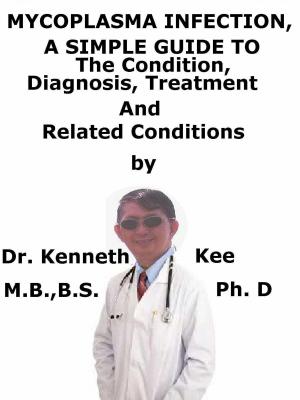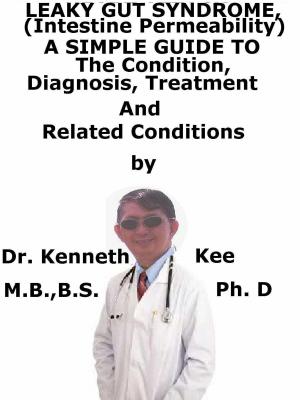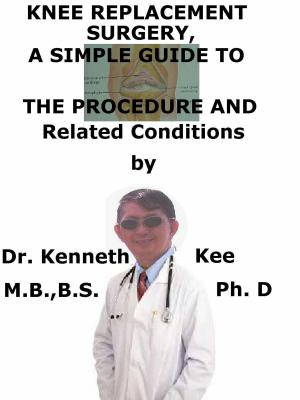Wolff-Parkinson- White-Syndrome, A Simple Guide To The Condition, Diagnosis, Treatment And Related Conditions
Nonfiction, Health & Well Being, Medical, Specialties, Internal Medicine, Cardiology, Health, Ailments & Diseases, Heart| Author: | Kenneth Kee | ISBN: | 9781370562077 |
| Publisher: | Kenneth Kee | Publication: | August 28, 2017 |
| Imprint: | Smashwords Edition | Language: | English |
| Author: | Kenneth Kee |
| ISBN: | 9781370562077 |
| Publisher: | Kenneth Kee |
| Publication: | August 28, 2017 |
| Imprint: | Smashwords Edition |
| Language: | English |
Wolff-Parkinson-White (WPW) syndrome is a congenital heart disorder in which an additional electrical connection in the heart can cause episodes of rapid heart rate (tachycardia)
WPW syndrome is one of the most frequent causes of fast heart rate disorders in infants and children.
Wolff-Parkinson-White (WPW) syndrome is a heart disorder that induces the heart to beat abnormally fast for periods of time.
It is a relatively frequent disorder, affecting between one and three in every 1,000 people.
Many WPW cases are diagnosed in otherwise healthy adults aged between 20 and 40.
Occasionally the extra electrical pathway will not cause any symptoms and may only be detected when an electrocardiogram (ECG) test is done for another disorder.
It can be frightening for the patient to be told that he or she has a problem with the heart, but WPW syndrome normally is not serious.
Many people will have no symptoms or only feel occasional, mild episodes of their fast heart rate.
WPW syndrome is a congenital abnormal disorder which can result in supra-ventricular tachycardia (SVT) that makes use of an atrioventricular (AV) accessory tract.
The additional pathway may also allow conduction during other supra-ventricular arrhythmias, such as atrial fibrillation or flutter.
With treatment, the disorder can normally be entirely cured.
Wolff-Parkinson-White syndrome is the most frequent of the ventricular pre-excitation syndromes
A person with this syndrome may have:
1. Chest pain or chest tightness
2. Dizziness
3. Lightheadedness
4. Fainting
5. Palpitations
If the patient has WPW syndrome, the patient will feel events where the heart suddenly starts racing, before stopping or slowing down suddenly.
A physical examination done during a tachycardia episode will reveal a heart rate faster than 100 beats per minute.
The normal heart rate is 60 to 100 beats per minute in adults, and under 150 beats per minute in newborns, infants, and small children.
The disorder may be diagnosed with an ECG or with continual or person triggered ambulatory ECG monitoring, such as a Holter monitor.
A procedure called an electrophysiologic study (EPS) is done using catheters placed in the heart.
This test may help detect the site of the additional electrical pathway.
Classic ECG findings of WPW syndrome are a short PR interval (smaller than 120 ms), a wide QRS complex of more than 120 ms with a slurred onset producing a delta wave in the early part of QRS and secondary ST-T wave alterations
Asymptomatic patients may just require periodic assessment.
The main types of treatment are drug therapy, radiofrequency (RF) ablation and surgical ablation.
Radiofrequency ablation is the first-line treatment for symptomatic WPW syndrome.
It has substituted surgical treatment and most drug treatments.
Medicines, mainly anti-arrhythmic drugs such as procainamide or amiodarone, may be given to control or stop a rapid heartbeat.
If the heart rate does not return to normal with medical treatment, the doctors may make use of a form of treatment called cardioversion (electrical shock).
The long-term treatment for WPW syndrome is very often catheter RF ablation.
This intervention needs inserting a tube (catheter) into a vein through a small incision near the groin up to the heart area.
When the tip enters the heart, the small area that is causing the fast heart rate is obliterated using a special type of energy called radiofrequency or by freezing it (cryoablation).
Open heart surgery to cauterize or freeze the additional pathway may also give a permanent cure for WPW syndrome.
In most cases, this intervention is done only if the patient requires heart surgery for other reasons.
TABLE OF CONTENT
Introduction
Chapter 1 Wolff-Parkinson-White Syndrome
Chapter 2 Causes
Chapter 3 Symptoms
Chapter 4 Diagnosis
Chapter 5 Treatment
Chapter 6 Prognosis
Chapter 7 Atrial Flutter
Chapter 8 Palpitations
Epilogue
Wolff-Parkinson-White (WPW) syndrome is a congenital heart disorder in which an additional electrical connection in the heart can cause episodes of rapid heart rate (tachycardia)
WPW syndrome is one of the most frequent causes of fast heart rate disorders in infants and children.
Wolff-Parkinson-White (WPW) syndrome is a heart disorder that induces the heart to beat abnormally fast for periods of time.
It is a relatively frequent disorder, affecting between one and three in every 1,000 people.
Many WPW cases are diagnosed in otherwise healthy adults aged between 20 and 40.
Occasionally the extra electrical pathway will not cause any symptoms and may only be detected when an electrocardiogram (ECG) test is done for another disorder.
It can be frightening for the patient to be told that he or she has a problem with the heart, but WPW syndrome normally is not serious.
Many people will have no symptoms or only feel occasional, mild episodes of their fast heart rate.
WPW syndrome is a congenital abnormal disorder which can result in supra-ventricular tachycardia (SVT) that makes use of an atrioventricular (AV) accessory tract.
The additional pathway may also allow conduction during other supra-ventricular arrhythmias, such as atrial fibrillation or flutter.
With treatment, the disorder can normally be entirely cured.
Wolff-Parkinson-White syndrome is the most frequent of the ventricular pre-excitation syndromes
A person with this syndrome may have:
1. Chest pain or chest tightness
2. Dizziness
3. Lightheadedness
4. Fainting
5. Palpitations
If the patient has WPW syndrome, the patient will feel events where the heart suddenly starts racing, before stopping or slowing down suddenly.
A physical examination done during a tachycardia episode will reveal a heart rate faster than 100 beats per minute.
The normal heart rate is 60 to 100 beats per minute in adults, and under 150 beats per minute in newborns, infants, and small children.
The disorder may be diagnosed with an ECG or with continual or person triggered ambulatory ECG monitoring, such as a Holter monitor.
A procedure called an electrophysiologic study (EPS) is done using catheters placed in the heart.
This test may help detect the site of the additional electrical pathway.
Classic ECG findings of WPW syndrome are a short PR interval (smaller than 120 ms), a wide QRS complex of more than 120 ms with a slurred onset producing a delta wave in the early part of QRS and secondary ST-T wave alterations
Asymptomatic patients may just require periodic assessment.
The main types of treatment are drug therapy, radiofrequency (RF) ablation and surgical ablation.
Radiofrequency ablation is the first-line treatment for symptomatic WPW syndrome.
It has substituted surgical treatment and most drug treatments.
Medicines, mainly anti-arrhythmic drugs such as procainamide or amiodarone, may be given to control or stop a rapid heartbeat.
If the heart rate does not return to normal with medical treatment, the doctors may make use of a form of treatment called cardioversion (electrical shock).
The long-term treatment for WPW syndrome is very often catheter RF ablation.
This intervention needs inserting a tube (catheter) into a vein through a small incision near the groin up to the heart area.
When the tip enters the heart, the small area that is causing the fast heart rate is obliterated using a special type of energy called radiofrequency or by freezing it (cryoablation).
Open heart surgery to cauterize or freeze the additional pathway may also give a permanent cure for WPW syndrome.
In most cases, this intervention is done only if the patient requires heart surgery for other reasons.
TABLE OF CONTENT
Introduction
Chapter 1 Wolff-Parkinson-White Syndrome
Chapter 2 Causes
Chapter 3 Symptoms
Chapter 4 Diagnosis
Chapter 5 Treatment
Chapter 6 Prognosis
Chapter 7 Atrial Flutter
Chapter 8 Palpitations
Epilogue















